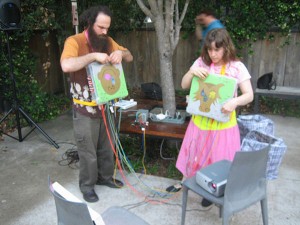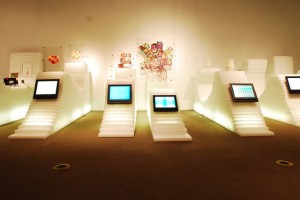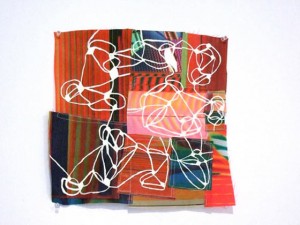 LoVid is an interdisciplinary artist duo comprised of Tali Hinkis and Kyle Lapidus who have been collaborating for over twelve years and married nearly as long. LoVid’s range is wide: they perform using hand-made electronics and interactive choreographies, they create sculpture, video, prints, and large scale installations. Their work combines materials both “hard” (electronic and wireless technologies, scientific data) and “soft” (fabric, paper, human bodies), and highlights the flawed apparatuses through which humans perceive and interpret. FPP Harlem interviewed them separately and they were not aware of the other’s answers.
LoVid is an interdisciplinary artist duo comprised of Tali Hinkis and Kyle Lapidus who have been collaborating for over twelve years and married nearly as long. LoVid’s range is wide: they perform using hand-made electronics and interactive choreographies, they create sculpture, video, prints, and large scale installations. Their work combines materials both “hard” (electronic and wireless technologies, scientific data) and “soft” (fabric, paper, human bodies), and highlights the flawed apparatuses through which humans perceive and interpret. FPP Harlem interviewed them separately and they were not aware of the other’s answers.
How would you describe the other’s role in the collaboration?
Tali: Kyle is the concrete thinker. I need to articulate ideas to him in a functional and concrete way, not abstractly and metaphorically. He sees things I don’t and sometimes the other way around. He sees maybe with a different filter on or different measuring tools. He is the technologist. He adds scientific references and inspirations. He’s the spelling/grammar checker. The deadline enforcer.
Kyle: This varies piece to piece. Aside from springboarding off of each other, we sometimes have individual tasks like sewing or soldering, but in the end our individual actions end up very similar to one another.
When you’re working on new pieces, how do you deploy “No” and “Yes” with one another?
Tali: It used to be in the way of IS and IS NOT. Earlier in our collaborating we would challenge what is or is not “LoVid”. Since we decided to expand the definition of LoVid to “anything we do” it became easier to allow ideas to come in.
We rarely totally shut down each other’s ideas. Usually we list and explain why we don’t like the idea: it’s too big of a switch from the direction we are focusing on at the moment, or something about the form, technique, or concept is too forced, not personal to us, contextually irrelevant, or too relevant/popular. YES works out as different levels of understanding one another with sketching and referencing and googling at the same time.
Kyle: We probably use “no” most often in the pre-planning stages when there’s an idea one of us has or when the other hears that idea and responds with a variation. As we move through the process there are more “yeses.” Of course there’s occasional tweaking when something doesn’t come out matching the original vision but that’s more an issue for me because Tali is much happier to let quantum mechanics, gravity, and plain old chance run havoc, letting the chips fall where they may.
 How would you describe your process? Do you have a metaphor for the movement between having an idea or urge and arriving at the physical piece?
How would you describe your process? Do you have a metaphor for the movement between having an idea or urge and arriving at the physical piece?
Tali: This is just my feeling, we’ve never talked about it before: the beginning is maybe like waking up from an important dream, having a hard time remembering the details. Or even better: like putting together the pieces of an old memory. Throwing the details of our story in to put together the full picture.
It is actually hard to think about it because every project is different. The more elaborate projects that take a long time with lots of planning and production are like going on a long walk. We have a destination and we are aware of it, but we worry: who will be there, what will it smell like, will I be happy there, will I be lonely there, what should I wear, why am I going there, maybe it’s a waste of time, what’s the point really, I promised I’d go.. etc, etc… We are so “in our heads” that we forget to look around at where we are sometimes.
But every once in a while something happens on the journey and we realize we are together. Or something happens that catches my eye or my attention and it’s like enlightenment, like a secret, something special for only me to experience, small or big it is completely subjective; and I know that I cannot translate it but it will stay with me and the people I meet will recognize that. Even together we share these moments and then we are calm and confident and whole.
Kyle: Our process varies piece by piece, like the work. Some have a lot of planning and are clearly developed from an idea. This is usually how I like to work. There are others that evolve naturally or just emerge fully formed. Tali likes that method. For me, the idea is like looking out over the ocean and that’s how I want the piece to be, but Tali likes to feature all the dunes grass on the way to the shore.
 Does a conversation about a piece feel similar or progress similarly to a conversation about, say, lunch?
Does a conversation about a piece feel similar or progress similarly to a conversation about, say, lunch?
Tali: No, though it could. We really analyze and talk practically and abstractly, theoretically and symbolically about every aspect of the work, trying to make it all fit. We’re trying to come up with a story that works. It’s more like planning a birthday party.
Kyle: We get more heated over a piece. It also feels like there’s more need for consensus and more critical thought than lunch. Plus with lunch we always know that we don’t need to eat exactly the same meal, which is a relief.
What is your biggest aesthetic/conceptual disagreement?
Tali: We don’t always agree on what the right balance between messy and tidy is. Between doing too much, too little, so much that it’s good or soo much that it’s bad and the other way around. I don’t think we have conceptual disagreements.
Kyle: Mostly about how much to follow a plan and how tight things should be.
What is the most productive convergence between you?
Tali: Performing. We have a great non-verbal communication when we perform. It’s very physical and we have to be very “in the present” and very aware and respectful of one another. When it is good it, is very emotional and fulfilling. I guess the great thing about performing is that the process is the creation and ideas and presentation all at once and we are really one with the audience and each other and the instrument.
Kyle: We really balance each other’s personalities in almost all ways and help each other be more ourselves. I think our most productive convergence isn’t anything specific, but just us.
